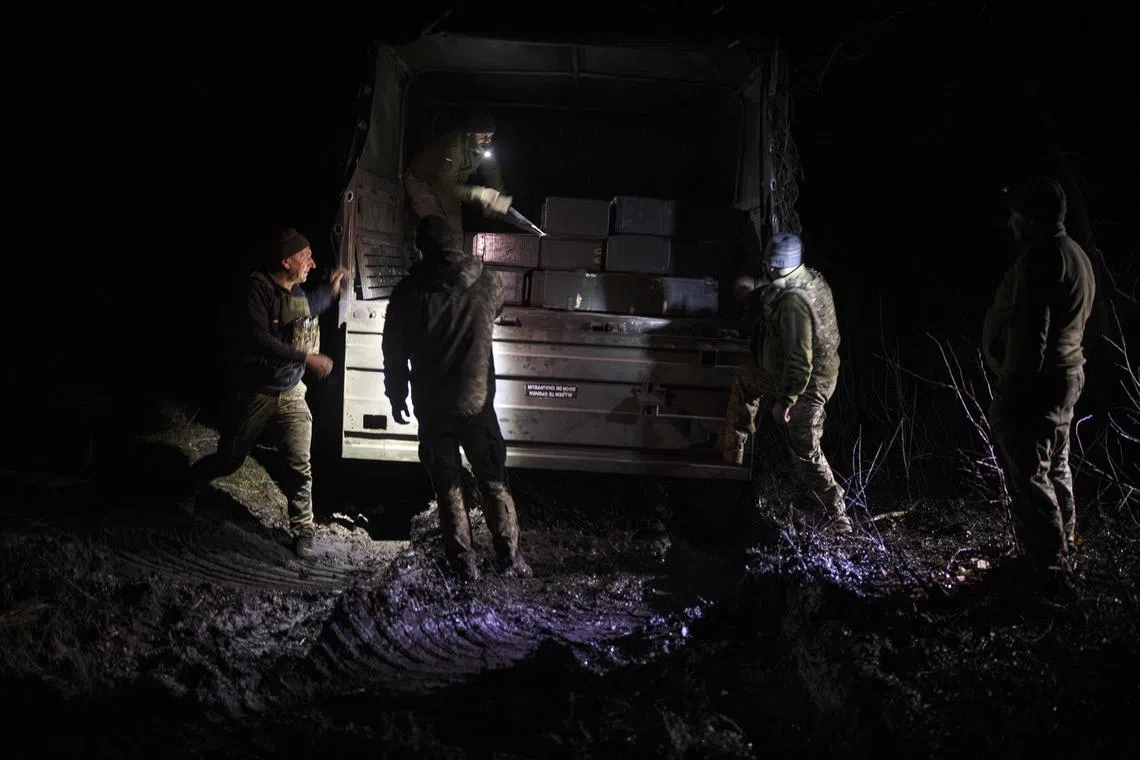US and Europe eye Russian assets to aid Ukraine as funding dries up
Sign up now: Get ST's newsletters delivered to your inbox

With the current funding exhausted, US officials have said they are scrambling to find ways to provide aid for Ukraine.
PHOTO: NYTIMES
Follow topic:
WASHINGTON - The Biden administration is quietly signalling new support for seizing more than US$300 billion (S$398 billion) in Russian central bank assets stashed in Western nations and has begun urgent discussions with allies about using the funds to aid Ukraine’s war effort at a moment when financial support is waning, according to senior American and European officials.
Until recently, Treasury Secretary Janet Yellen had argued that without action by Congress, seizing the funds was “not something that is legally permissible in the United States”.
There has also been concern among some top US officials that nations around the world would hesitate to keep their funds at the New York Federal Reserve, or in dollars, if the United States established a precedent for seizing the money.
But the administration, in coordination with the Group of 7 (G-7) industrial nations, has begun taking another look at whether it can use its existing authorities or if it should seek congressional action to use the funds.
Support for such legislation has been building in Congress, giving the Biden administration optimism that it could be granted the necessary authority.
The talks among finance ministers, central bankers, diplomats and lawyers have intensified in recent weeks, officials said, with the Biden administration pressing Britain, France, Germany, Italy, Canada and Japan to come up with a strategy by Feb 24, the second anniversary of the invasion.
The more than US$300 billion of Russian assets under discussion have already been out of Moscow’s control for more than a year.
After the invasion of Ukraine, the United States, along with Europe and Japan, used sanctions to freeze the assets,
But seizing the assets would take matters a significant step further and require careful legal consideration.
President Joe Biden has not yet signed off on the strategy, and many of the details remain under heated discussion. Policymakers must determine if the money will be channelled directly to Ukraine or used to its benefit in other ways.
They are also discussing what kinds of guardrails might be associated with the funds, such as whether the money could be used only for reconstruction and budgetary purposes to support Ukraine’s economy, or whether – like the funds Congress is debating – it could be spent directly on the military effort.
The discussions have taken on greater urgency since Congress failed to reach a deal to provide military aid before the end of the year.
On Dec 19, lawmakers abandoned a last-ditch effort amid a stalemate over Republicans’ demands that any aid be tied to a crackdown on migration across the US border with Mexico.
The Financial Times reported earlier that the Biden administration had come around to the view that seizing Russia’s assets was viable under international law.
A senior administration official said this week that even if Congress ultimately reached a deal to pay for more arms for Ukraine and aid to its government, eroding support for the war effort among Republicans and Ukraine’s increasingly precarious military position made it clear that an alternative source of funding was desperately needed.
US officials have said that current funding for the Ukrainians is nearly exhausted,
With Europe’s own promise of fresh funds also stuck, a variety of new ideas are being debated about how to use the Russian assets, either dipping into them directly, using them to guarantee loans or using the interest income they earn to help Ukraine.
“This amount of money that we’re talking about here is simply game-changing,” said Mr Philip Zelikow, a State Department official in both Bush administrations and a senior fellow at Stanford University’s Hoover Institution. “The fight over this money which is occurring is actually in some ways the essential campaign of the war.”
Seizing such a large sum of money from another sovereign nation would be without precedent, and such an action could have unpredictable legal ramifications and economic consequences. It would almost certainly lead to lawsuits and retaliation from Russia.
Ukraine President Volodymyr Zelensky referred to the discussions in a video address to his country, saying that “the issue of frozen assets was one of the very important decisions addressed” during his recent talks in Washington.
He seemed to suggest that the funds should be directed to arms purchases, adding: “The assets of the terrorist state and its affiliates should be used to support Ukraine, to protect lives and people from Russian terror.”In a sign that some European countries are ready to move forward with confiscating Russian assets, German prosecutors this week seized about US$790 million from the Frankfurt bank account of a Russian financial firm that was under European Union sanctions.
The Biden administration has said little in public about the negotiations. At the State Department on Dec 19, Mr Matthew Miller, a spokesman, said: “It’s something that we have looked at. There remains sort of operational questions about that, and legal questions.”
He said he did not have more information.
Very little of the Russian assets – perhaps US$5 billion or so, by some estimates – are in the hands of US institutions.
But a significant chunk of Russia’s foreign reserves are held in US dollars, both in the United States and in Europe. The United States has the power to police transactions involving its currency and use its sanctions to immobilise dollar-denominated assets.
The bulk of the Russian deposits are believed to be in Europe, including in Switzerland and Belgium, which are not part of the G-7. As a result, diplomatic negotiations are underway over how to gain access to those funds, some of which are held in euros and other currencies.
US officials were surprised that President Vladimir Putin did not repatriate the funds before the Ukraine invasion.
But in interviews over the past year, they have speculated that Mr Putin did not believe the funds would be seized, because they were left untouched after his invasion and annexation of Crimea in 2014.

Ukrainian President Volodymyr Zelensky (centre) with Senate minority leader Mitch McConnell (left) and Senate majority leader Chuck Schumer at the US Capitol in Washington, on Dec 12.
PHOTO: NYTIMES
And bringing the funds home to Russia would have been another tip-off that an invasion was imminent, at a time Mr Putin was vigorously denying US and British charges that he was preparing for military action.
One G-7 official said the coalition had been considering a variety of options for how to use Russia’s assets, with the goal of putting forward a unified proposal around the second anniversary of the war, when many top officials will be gathering in Germany for the Munich Security Conference.
The first debates have focused on what would be permissible under international law and under each nation’s domestic laws as they consider Russia’s likely legal responses and retaliatory measures.
Settling on a solid legal rationale has been one of the biggest challenges for policymakers as they decide how to proceed.
Proponents of seizing Russia’s assets, such as Mr Zelikow and former Treasury secretary Lawrence Summers, have argued that nations that hold Russian assets are entitled to cancel their obligations to Russia and apply those assets to what Russia owes for its breach of international law under the so-called international law of state countermeasures.
They note that after Iraq’s invasion of Kuwait in 1990, US$50 billion of Iraqi funds were seized and transferred through the United Nations to compensate victims in Iraq and other countries.
One of the obstacles in the United States for seizing Russian assets has been the view within the Biden administration that being able to lawfully do so would require an act of Congress. At a news conference in Germany in 2022, Dr Yellen highlighted that concern.
“While we’re beginning to look at this, it would not be legal now, in the United States, for the government to seize those statutes,” Dr Yellen said. “It’s not something that is legally permissible in the United States.”
Since then, however, Dr Yellen has become more open to the idea of seizing Russia’s assets to aid Ukraine.
Factions of Congress have previously tried to attach provisions to the annual defence Bill to allow the Justice Department to seize Russian assets belonging to officials under sanction and funnel the proceeds from the sale of those assets to Ukraine to help pay for weapons.
But the efforts have faltered amid concerns that the proposals were not thoroughly vetted.
With Ukraine running low on funds and ammunition, the debate about how to provide more aid could shift from a legal question to a moral question.
“One can understand the precedential point made by those who do not believe the assets should be seized,” said Mr Mark Sobel, a former long-time Treasury Department official who is now the US chair of the Official Monetary and Financial Institutions Forum. “Given skirmishes and wars in many spots, one could easily argue such a precedent could get out of hand.”
However, Mr Sobel argued that the barbarity of Russia’s actions justified using its assets to compensate Ukraine.
“In my mind, humanity dictates that those factors outweigh the argument that seizing the assets would be unprecedented simply because Russia’s heinous and unfathomable behaviour must be strongly punished,” he said. NYTIMES

